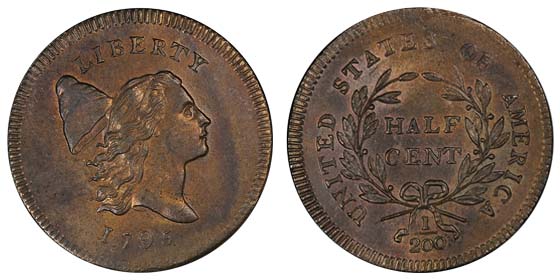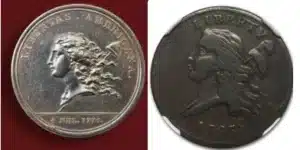Liberty Cap Half Cent Values
How Much Liberty Cap Half Cents are Worth: Liberty Cap Half Cent Values & Coin Price Chart

Year | Mint | Variety | Designation | VG-8 | F-12 | VF-20 | EF-40 | AU-50 | U-60 | MS-63 | MS-64 | MS-65 | MS-66 | MS-67 |
|---|---|---|---|---|---|---|---|---|---|---|---|---|---|---|
1800 | P | Plain 4- Stemless Wreath | Red-brown | 200 | 300 | 400 | 500 | 600 | 700 | 800 | 900 | 1000 | 1200 | 1100 |
| Year | Mint | Variety | Designation | VG-8 | F-12 | VF-20 | EF-40 | AU-50 | MS-60 | MS-63 | MS-64 | MS-65 | MS-66 |
|---|---|---|---|---|---|---|---|---|---|---|---|---|---|
| 1793 | (None) Phil | -- | BN | $5,545 | $8,990 | $15,000 | $21,800 | $34,995 | $60,000 | $101,500 | $130,500 | $350,000 | $985,000 |
| 1793 | (None) Phil | -- | RB | -- | -- | -- | -- | -- | -- | $160,500 | -- | -- | -- |
| 1794 | (None) Phil | -- | BN | $1,233 | $1,965 | $2,610 | $5,560 | $10,675 | $20,700 | $70,600 | $88,000 | $159,000 | $302,500 |
| 1794 | (None) Phil | -- | RB | -- | -- | -- | -- | -- | -- | -- | -- | $208,000 | $362,000 |
| 1794 | (None) Phil | Low Relief Head | BN | $1,233 | $2,340 | $2,935 | $6,935 | $11,175 | $25,200 | $70,600 | $88,000 | $159,000 | $307,500 |
| 1794 | (None) Phil | High Relief Head | BN | $1,720 | $2,590 | $3,310 | $6,185 | $10,175 | $21,950 | $70,600 | $98,000 | $206,500 | $407,500 |
| 1794 | (None) Phil | High Relief Head | RB | -- | -- | -- | -- | -- | -- | -- | $235,000 | $250,500 | $437,000 |
| 1795 | (None) Phil | Plain Edge, Punctuated Date | BN | $1,078 | $1,503 | $2,490 | $5,075 | $12,650 | $26,950 | $81,500 | -- | -- | -- |
| 1795 | (None) Phil | Plain Edge, No Pole | BN | $1,128 | $1,503 | $2,380 | $5,075 | $6,860 | $19,950 | $33,900 | $61,200 | $121,750 | $235,000 |
| 1795 | (None) Phil | LE, Punctuated Date | BN | $1,618 | $2,160 | $3,143 | $7,888 | $11,075 | $29,750 | $77,250 | $123,250 | $184,750 | -- |
| 1795 | (None) Phil | Lettered Edge | BN | $1,155 | $1,910 | $2,600 | $5,575 | $7,850 | $21,300 | $57,750 | $104,250 | $140,500 | $213,000 |
| 1796 | (None) Phil | No Pole | BN | $71,750 | $136,000 | $182,500 | $231,000 | $286,000 | $374,000 | $567,000 | $687,500 | $833,000 | -- |
| 1796 | (None) Phil | With Pole | BN | $28,750 | $40,500 | $54,750 | $79,500 | $97,000 | $190,000 | $247,000 | $291,000 | $368,000 | $440,000 |
| 1796 | (None) Phil | With Pole | RB | -- | -- | -- | -- | -- | -- | -- | $375,000 | $391,500 | $476,000 |
| 1797 | (None) Phil | 1 Above 1 | BN | $1,128 | $1,503 | $2,380 | $5,075 | $6,860 | $19,950 | $32,650 | $68,070 | $126,425 | $220,750 |
| 1797 | (None) Phil | 1 Above 1 | RB | -- | -- | -- | -- | -- | -- | -- | $115,000 | $185,000 | $325,000 |
| 1797 | (None) Phil | Plain Edge | BN | $1,155 | $1,585 | $2,380 | $5,295 | $10,325 | $29,875 | $47,000 | $83,000 | $147,500 | $338,750 |
| 1797 | (None) Phil | Low Head, Plain Edge | BN | $1,375 | $2,700 | $4,500 | $12,500 | $70,000 | -- | $225,000 | -- | -- | -- |
| 1797 | (None) Phil | Lettered Edge | BN | $3,425 | $6,990 | $12,375 | $30,700 | $55,000 | -- | -- | -- | -- | -- |
| 1797 | (None) Phil | Gripped Edge | BN | $141,500 | $225,000 | -- | -- | -- | -- | -- | -- | -- | -- |
Description and History
In April of 1792, the newly formed United States Congress passed the 1792 Coinage Act. This bill provided for the establishment of a United States Mint facility to be built in the then-capital of the United States – Philadelphia. The Act additionally established the United States Dollar as our standard unit of currency, it deemed it to be legal tender and it laid out the regulations for our currency – such as some of the various legends and mottoes that needed to be placed on our coinage.
President George Washington appointed David Rittenhouse to be the first Director of the United States Mint. One of the provisions of the Act was that the President should have his likeness on the obverse of our coinage, just as many world monarchs had their portraits on the coinage of the countries that they ruled. But Washington would have none of that. Since the very first coinage of the Roman Empire, portraits of the reigning emperor always adorned their coins. But Washington did not want to follow England, the country that we had just fought to gain our independence, in having our leaders on our coins. So, it was decided that allegorical representations of Liberty would be the dominant images on our American coinage.
In May of 1792 Washington signed into law an Act to Provide for Copper Coinage which mandated that a half cent coin and one cent coins would be struck. The Director was authorized to purchase up to one hundred fifty tons of copper to be the base material for the coins. Henry Voigt was the Chief Coiner of the US Mint and he looked for inspiration everywhere in designing the country’s first coins.
Augustin Dupre, the French Medallist and Coin Engraver, inspired Voight by creating a medal called the Libertas Americana medal. Designed by Benjamin Franklin when he was Ambassador to France, and executed by Dupre, the portrait displayed of Miss Liberty facing left, hair blowing in the breeze.

Voigt’s design was well-received, but Washington thought it a bit too simplistic in its design. Nevertheless, production began late in 1793 but only 35,334 coins were struck. The reverse had the words “HALF CENT” inside of a wreath with berries. Below the wreath was the denomination (1/200) and above it was “UNITED STATES OF AMERICA.”
Robert Scot was commissioned as Chief Engraver in November of 1793 and one of his first tasks was to redesign the Half Cent for 1794. He turned Miss Liberty to face right and enlarged the cap that was on the pole behind the head of Miss Liberty. The cap and pole represented “freemen, who were not enslaved.”
The Half Cents dated 1795 through 1797 were re-cut by Assistant engraver John Gardner who lowered the relief (thickness) of the Miss Liberty design and slightly reduced the size of Miss Liberty herself.
Coins from this early period (1793 to 1797) often vary in quality as the copper blanks on which they were struck often varied in quality themselves.
There are varieties of all these dates that are much rarer and even more valuable. No proof strikings are known. All coins were struck at the Philadelphia Mint.

